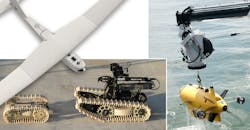UAVs and UGVs Ready to Serve on the Battlefield and Beyond (.PDF Download)
Machines no longer require the press of a button to start the power, especially for military missions. Autonomy is coming rapidly to robots and unmanned machines for military applications. They come in the forms of unmanned aerial vehicles (UAVs) and unmanned ground vehicles (UGVs) that can function without an operator, with the aid of artificial intelligence (AI) and environmental sensors. Significant investments by governments on behalf of military robotic applications are literally driving autonomous robotic technologies full speed ahead toward the vision of a battlefield where humans and machines team as partners.
Robots and unmanned vehicles, which have been part of the military landscape for some time, are increasingly used by all four branches of the U.S. military as well as by military forces around the world. Advances in electronic hardware and software support a trend of greater autonomy in these machines, making them more independent from the humans who create them. Military requirements for reduced size, weight, and power (SWaP) also make UAVs, UGVs, and ground robots smaller and lighter.
